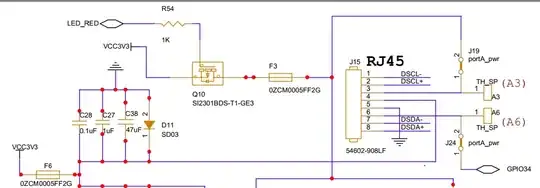I have designed a MDD SD03 across a 3v3 supply. The 3v3 is being carried through a cat5 cable via an RJ45 socket. I assume this is totally fine, although can someone who knows about these devices confirm this before I send them off for production?

- 159
- 6
-
send what off to production? – jsotola Jun 23 '21 at 22:28
-
gerber files using the linked part.... – Bringle Jun 23 '21 at 22:32
-
Please provide a schematic. Explain in detail what EMI might be picked up by the cable. Explain what your reasoning is for selecting this TVS...what are you trying to protect, and from what hazard? – Elliot Alderson Jun 23 '21 at 23:01
-
I have added a schematic, just very basic protection, protecting the local 3v3 supply from static discharges etc – Bringle Jun 23 '21 at 23:38
-
If you are worried about static discharges then it would also probably make sense to protect the data lines. – Wesley Lee Jun 23 '21 at 23:52
1 Answers
Let's assume that ESD, fast transients (EFTs) and slow transients (surges) my occur in some way (and they correspond to the IEC/EN 61000-4-2, -4-4 and -4-5 immunity tests, that are due since we speak of "production").
What is the current released during one of these tests? it depends of course on the test voltage, that depends on the application: let's assume Industrial (if it railways, aircraft, military it is a bit different, and worse).
It's a signal port, so EFTs are tested at 1 kV, surges also at 1 kV... both polarities! both tests are only line-ground.
- the EFT generator has an output imp of 50 ohm, so you end up with 20 A short circuit current; good
- the surge generator including the coupling-decoupling has output impedance of 42 ohm, so about 25 A. good/not good**
**it depends on the voltage across the TVS during the discharge (clamping voltage), because the withstanding capability for the surges is given in Watts. As you see in the datasheet it has Vc=14V @ 20A, but we will have 25A, so it might work, but it's on the edge. The test is repeated several times and the TVS will go smoke sooner or later (too tight).
You need something a bit bigger for surges.
Be careful that tests are both polarities, but this TVS is unipolar.
Last point. You posted a schematic. For ESD and EFTs## it is quite important that the TVS is very close to the entry point to reduce the path of the discharge current and limit it to the edge of the board, also reducing resonances. It may be helpful to add a small ferrite on the cable. In extreme cases ferrite beads may be added to the pins of the connector soldered to the PCB, but it is seldom the case.
##it is important also for surges, but they are slower waveforms with less high-frequency components. For ESD and EFTs it is imperative.
A TVS like that is sufficiently
- 1,599
- 9
- 13
-
Thank you for the great information, design is for consumer use. I was thinking a unidirectional TVS would be specified for DC (not very familiar with their use...)? – Bringle Jun 24 '21 at 02:58
-
Welcome!. The price difference is almost nothing, so you get 2 :). Have look at this app note: https://www.mouser.com/pdfdocs/AND8424-D.PDF -- for this energy (we spoke of 20-25 A) integrated TVS where there are e.g. 2 or 4 in the same package are hard to find, they are small, but you can have a quick search. – andrea Jun 24 '21 at 06:54